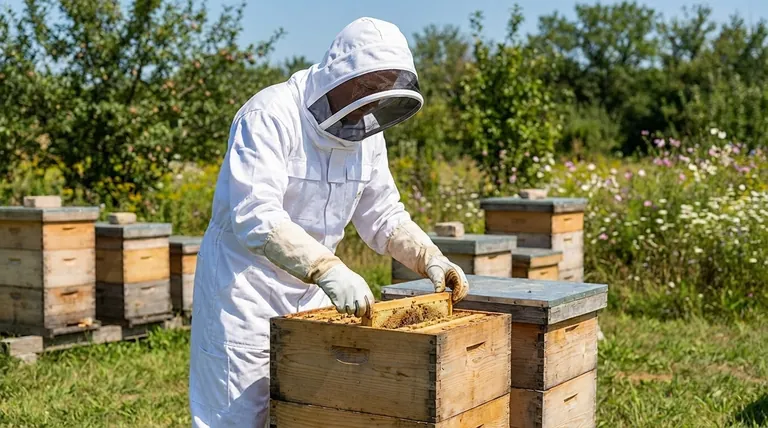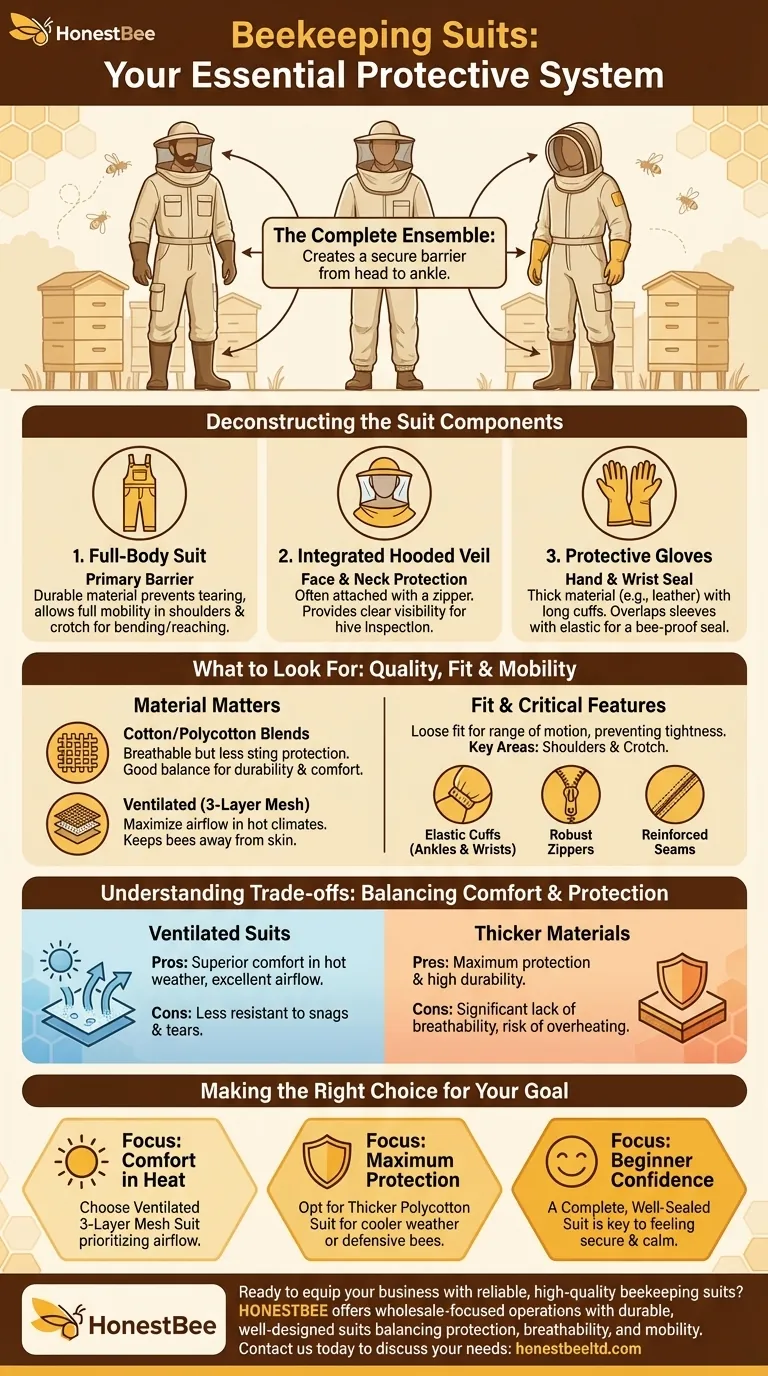A standard beekeeping suit typically includes a set of full-body overalls with an integrated hooded veil and a pair of protective gloves. This complete ensemble is designed to create a secure barrier between you and the bees, covering you from head to ankle.
The core purpose of a beekeeping suit isn't just to provide individual items, but to function as a complete protective system. A full setup includes the main suit, an integrated veil, and specialized gloves to ensure no skin is exposed, giving you the confidence to work calmly and effectively.

Deconstructing the Beekeeping Suit
Understanding the function of each component helps clarify why a complete package is essential for safety and comfort.
The Full-Body Suit
The main garment is a set of overalls designed for full coverage. It serves as the primary barrier against stings.
Quality suits are made from durable materials that prevent tearing and allow for full mobility in the shoulders and crotch. This ensures you can bend, lift, and reach without restriction.
The Integrated Hooded Veil
The veil is almost always attached to the suit, often with a zipper. It protects your face and neck, the most sensitive areas.
This component is critical for keeping bees away from your face while providing the visibility needed to inspect the hive.
The Essential Gloves
A beekeeping suit package includes specialized gloves. These are typically made of a thicker material like leather for hand protection, with longer cuffs that extend up the arm.
The gloves overlap with the suit's sleeves, and the elastic cuffs on both create a bee-proof seal at the wrists.
What to Look for in a Quality Suit
Beyond the basic components, specific features determine a suit's effectiveness, comfort, and durability.
Material Matters: Protection vs. Breathability
The material directly impacts your experience. Cotton is breathable and comfortable but may offer less sting protection than thicker fabrics.
Polycotton blends provide a good balance of durability and comfort. For hot climates, ventilated suits with a 3-layer mesh construction are ideal, as they maximize airflow while keeping bees away from your skin.
The Importance of Fit and Mobility
A well-fitting suit is a safe suit. It should be loose enough to allow a full range of motion without pulling tight against your skin, which could make stings more likely.
Look for suits designed to prevent tightness in key areas like the shoulders when reaching or the crotch when bending over.
Critical Protective Features
Elastic cuffs at the ankles and wrists are non-negotiable. They are vital for blocking bees from crawling inside your suit.
High-quality suits often feature robust zippers and reinforced seams to ensure long-term durability and protection.
Understanding the Trade-offs
Choosing a beekeeping suit involves balancing competing priorities. There is no single "best" suit for every person and every climate.
Ventilated Suits: Comfort vs. Durability
Ventilated mesh suits offer superior comfort in hot weather by allowing for excellent airflow.
However, the mesh material may be less resistant to snags and tears from sharp objects compared to traditional polycotton canvas.
Thicker Materials: Protection vs. Heat
Thicker, non-ventilated suits provide maximum protection and are highly durable.
The downside is a significant lack of breathability, which can lead to overheating and discomfort during long inspections in warm or humid climates.
Making the Right Choice for Your Goal
Select your gear based on your specific climate and beekeeping style.
- If your primary focus is comfort in a hot climate: Choose a ventilated, 3-layer mesh suit that prioritizes airflow.
- If your primary focus is maximum protection and durability: Opt for a thicker polycotton suit, especially if you work in cooler weather or with more defensive bees.
- If your primary focus is building confidence as a beginner: A complete, well-sealed suit of any material is key to feeling secure and calm while you learn.
Ultimately, your beekeeping suit is the critical tool that enables a safe and confident relationship with your hives.
Summary Table:
| Component | Key Features | Primary Function |
|---|---|---|
| Full-Body Suit | Durable material, full mobility design | Primary barrier against bee stings |
| Integrated Hooded Veil | Attached via zipper, clear visibility | Protects face and neck, critical for hive inspection |
| Protective Gloves | Leather or thick material, long cuffs | Hand and wrist protection, creates a bee-proof seal |
Ready to equip yourself or your business with reliable, high-quality beekeeping suits?
At HONESTBEE, we understand that safety and comfort are paramount for commercial apiaries and equipment distributors. Our wholesale-focused operations provide durable, well-designed suits that balance protection, breathability, and mobility to meet the demands of professional beekeeping.
Contact us today to discuss your specific needs and discover how our beekeeping supplies can enhance your operations and protect your investment.
Visual Guide

Related Products
- Cotton Beekeeping Suit and Round Hat with Veil Bee Keeper Protective Gear
- White Beekeeping Protective Suit and Hat with Fencing Veil for Beekeepers
- Beekeeper Cowboy Hat and Veil for Beekeeping
- Heavy Duty Cowboy Beekeeper Hat with Visibility Veil Outdoor Professional Beekeeping Protective Gear
- Professional Beekeeping Suit for Kids and Girls Childrens Bee Keeper Suit
People Also Ask
- What are bee suits made of? Choosing the Right Material for Maximum Protection & Comfort
- What factors should be considered when choosing a beekeeping suit? Balance Safety, Comfort & Performance
- Do beekeeping suits completely prevent stings? Maximize Your Apiary Safety with the Right Gear
- What should be considered regarding the color of beekeeping clothing? Ensure Your Safety and Keep Bees Calm
- Why is white the predominant color in bee suit designs? | Key to Hive Calm & Beekeeper Safety



















